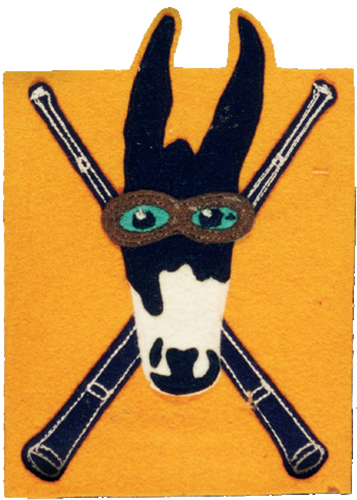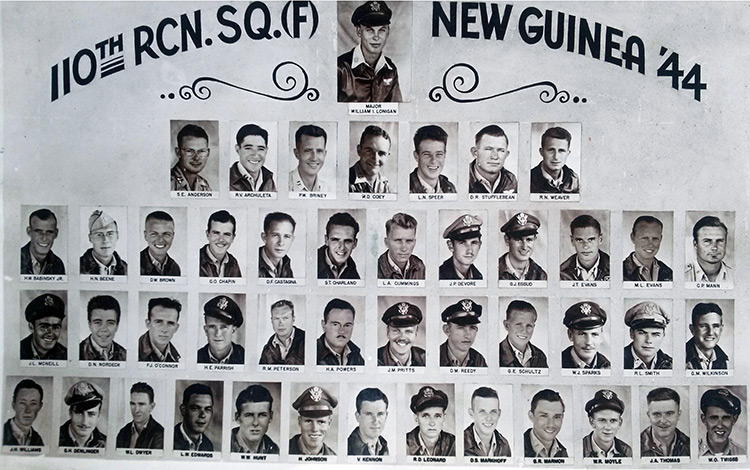110th Tactical Reconnaissance Squadron (110th TRS)
U.S. Army Air Force (USAAF), 5th Air Force (5th AF), 71st Tactical Reconnaissance Group
 Background Background
On August 14, 1917 organized as the 110th Aero Squadron. On February 1, 1918 redesignated 804th Aero Squadron. On July 23, 1918 based at Kelly Field in Texas. At the end of World War I on November 18, 1918 demobilized.
On June 23, 1923 reactivated at St. Louis with the Missouri National Guard flying the JN-4 Jenny for the 35th Infantry Division. On March 14, 1925 2nd Lieutenant Charles A. Lindbergh was assigned to the 110th Observation Squadron and served until 1929. In July 1931 moved to Lambert-St. Louis Municipal Airport.
On July 2, 1926 becomes part of the U.S. Army Air Corps (USAAC). During 1936, reconstituted and consolidated with the 110th Observation Squadron in the National Guard (NG). On January 3, 1941 moves to Little Rock, AR. On December 23, 1940 returned to active duty with the VII Army Corps. On September 1, 1940 assigned to II Air Support Command. On October 1, 1941 assigned to the 71st Observation Group (later renamed 71st Tactical Reconnaissance Group). On June 20, 1941 becomes part of the U.S. Army Air Force (USAAF).

Pilots of the 110th Rec. Sq. (F) New Guinea '44
Wartime History
 On December 22, 1941 moves to Salinas Army Airfield and begins flying anti-submarine off the coast of California with the 4th Air Force (4th AF). On January 13, 1942 redesignated as 110th Observation Squadron (Light). On July 4, 1942 redesigned as the 110th Observation Squadron. On August 16, 1942 ceases flying anti-submarine patrols. On January 28, 1943 moves to Esler Field, LA. On April 1, 1943 moves to Laurel Army Airfield in Mississippi. On December 22, 1941 moves to Salinas Army Airfield and begins flying anti-submarine off the coast of California with the 4th Air Force (4th AF). On January 13, 1942 redesignated as 110th Observation Squadron (Light). On July 4, 1942 redesigned as the 110th Observation Squadron. On August 16, 1942 ceases flying anti-submarine patrols. On January 28, 1943 moves to Esler Field, LA. On April 1, 1943 moves to Laurel Army Airfield in Mississippi.
On April 3, 1943 redesignated as 110th Reconnaissance Squadron (Fighter), abbreviated as 110th Rec. Sq. (F). Also known as 110th Tac Recon Squadron or 110th Tac Recon. In late 1943, departs the United States and cross the Pacific to Australia.
On December 5, 1943 arrives Brisbane and assigned to 5th Air Force (5th AF) with P-39Q Airacobras. On December 21, 1943 the squadron moves to Port Moresby in New Guinea.
On January 20, 1944 "A" flight arrives at Gusap Airfield. On January 21, 1944 they fly their first mission in New Guinea.
On January 23, 1944 lost is P-39 pilot McAlarney (MIA) on a mission over Uligan Harbor. At 8:45am, while strafing a Japanese barge, McAlarney turned to the right and his wingtip struck a tree causing his aircraft to cartwheel and crash nose first into Uligan Harbor.
On February 6, 1944 lost is P-39N pilot Gilpatrick (KIA) crashed on a combat mission over New Guinea.
On February 7, 1944 the entire squadron arrives at Gusap Airfield. On May 10, 1944 redesignated 110th Tactical Reconnaissance Squadron (110th TRS). On May 25, 1944 the flight echelon flying P-40 Warhawks begin operating from Tadji Airfield. On June 5, 1944 the entire squadron moves to Tadji Airfield.
On July 3, 1944 lost is P-39Q 42-19999 pilot 1st Lt. William J. Sparks (MIA) on a strafing mission against the Wewak area.
On July 6, 1944 lost is P-39N "Blazing Blonde" 42-18813 pilot 1st Lt. Gabriel J. Eggud (MIA) on a mission against the Wewak area. Over the target, the plane's bomb accidentally exploded causing it to crash.
On September 11, 1944 the squadron moves to Biak.
On November 3, 1944 the ground echelon moves to Dulag Airfield on Leyte. Meanwhile, the air echelon flying P-40 Warhawks operates from Tacloban Airfield on Leyte. On December 25, 1944 the flight echelon begins operating from San Jose Airfield on Mindoro. On January 4, 1945 the ground echelon begins moving from Leyte to Luzon.
On January 20, 1945 the ground echelon begins operating from Lingayen Airfield. On January 22, 1945 the air echelon of P-40 Warhawks moves to Lingayen Airfield. Later, the squadron operates the F-6 Mustang. On July 28, 1945 the squadron moves to Ie Shima Airfield off Okinawa until the official surrender of Japan on September 2, 1945.
Postwar
On October 20, 1945 assigned to the 7th Air Force (7th AF). On December 3, 1945 returned to the Far East Air Force (FEAF) and later Pacific Air Command, U.S. Army. On February 20, 1946 inactivated. On May 24, 1946 redesignated as the 110th Fighter Squadron and allocated to Air National Guard (ANG) flying F-51 Mustangs at Lambert Field at St. Louis. On September 18, 1947 becomes part of the U.S. Air Force (USAF).
On March 1, 1951 federalized and activated for service in the Korean War assigned to SAC (SAC) and moved to Bergstrom AFB, Texas and became part of the 131st Fighter-Bomber Group (131st FBG). In November 1951 moved to George AFB, California and continued to fly the F-51 Mustang. On December 1, 1952 released from active duty and reverted to the Air National Guard (ANG) and returned to Lambert Field. During January 1953 became a light bombardment squadron flying the B-26 Invader and trained to fly night missions.
In the spring of 1958 transitioned to fly the F-80 Shooting Star jet fighter for several months. In June 1958 equipped with the F-84F Thunderstreak jet fighter. In October 1961 deployed to deployed to Toul-Rosières Air Base, France as part of the 7131st Tactical Fighter Wing (Provisional).
On July 19, 1962 inactivated and returned to Lambert Field at St. Louis and equipped with the F-100C Super Saber jet fighter. In 1977, Anne Morrow Lindbergh, the widow of Charles A. Lindbergh gave the 110th Tactical Fighter Squadron permission to use the nickname "Lindbergh's Own". During the Vietnam War, the squadron was not activated for overseas service, but many pilots were assigned to other squadrons during the conflict.
During 1978, assigned F-4C Phantom II jet fighters. During 1991, upgraded to the F-15A/B Eagle fighter, as one of the last Air National Guard units to convert. On March 15, 1992 redesignated as the 110th Fighter Squadron (110th FS) with overseas deployments in Turkey and Operation Northern Watch enforcing the no-fly zone over Iraq for three tours during 1996, 1997 and 1998. On June 16, 2009 squadron's last F-15 was removed from service.
On October 4, 2008 redesignated as the
110th Bomb Squadron (110th BS) and remains part of the Missouri Air National Guard 131st Bomb Wing (131st BW) based at Whiteman Air Force Base (Whiteman AFB) in Knob Noster, Missouri and operates the Grumman B-2 Spirit. By August 2013, the 131st BW is the only Air National Guard Bomb Wing certified to conduct nuclear operations.
Awards
Distinguished Unit Citation Philippines (December 7, 1944–December 26, 1944)
Philippines Presidential Unit Citation
References
110th Tactical Reconnaissance Squadron, July 1944
Combat Squadrons of the Air Force World War II (1982) pages 339-340 [PDF pages 351-352]
U.S. Air Force (USAF) - 11th Bomb Squadron official web page
U.S. Air Force (USAF) - First ANG bomb wing certified for nuclear operations by Capt. Rachel Savage August 9, 2013
Rocky Boyer's War: An Unvarnished History of the Air Blitz that Won the War in the Southwest Pacific (2017) by Allen D. Boyer pages 19 (110th TRS)
Contribute Information
Do you have photos or additional information to add?
|
 Background
Background
